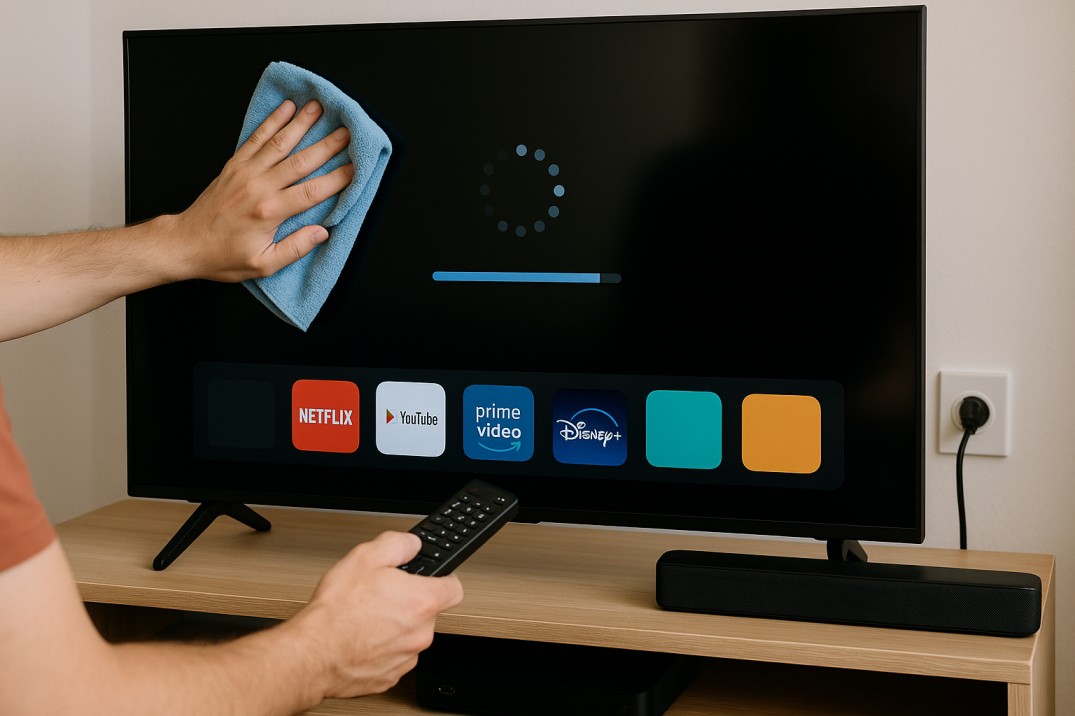To be perfectly candid, you cannot help but be annoyed when your smart TV freezes right as your favorite show reaches its cliffhanger. It could either be slow apps, a remote that takes several seconds to respond, or slow menus, yet each can turn an evening into a frustrating experience. The great news? You likely won’t have to toss your television and get a new one after all. After a bit of cleaning, maintenance, and optimizing your options, you will have your TV back in shape.
For this article, we will show you where and how to clean it and then speed it up — inside and out — so that you can enjoy smooth streaming again.
1. Start with a Physical Clean-Up
Before getting into the more technical side of this, let’s start with something simple, a physical clean-up. Over time dust and grime build on your TV screen, ports, and ventilation areas, which affect overall performance by leading to overheating and sluggish operation.
Here is how to safely clean your smart TV:
- Turn off and unplug the TV prior to any cleaning.
- Use a clean soft microfiber cloth, and wipe the screen gently. Be careful to NOT apply the pressure of a paper towel or a rough fabric.
- If you notice a sticky or stubborn spot, dampen the cloth with a 50/50 solution of water and vinegar and proceed with caution.
- Clean the air vents and HDMI ports using a can of compressed air, to free any trapped dust.
Keeping your TV physically clean helps prevent overheating, one of the leading causes of performance lag.
2. Clear Cache and Temporary Files
Similar to smartphones and computers, smart TVs save temporary data and cache files to improve app load time. But after a while, these files accumulate and can slow down your TV.
To fix this:
- Head to Settings > Apps > See All Apps (this could be different depending on your TV brand).
- Select the particular app that feels slow such as YouTube, Netflix or Prime Video.
- Then, select Clear Cache and Clear Data.
Completing this once every two or three weeks can greatly improve your TV’s speed and responsiveness.
3. Uninstall Unused Apps
How many of you downloaded that random wallpaper or fitness app six months ago? It’s likely still running in the background!
Apps that you are not currently using are still taking up storage space, and sometimes running without your knowledge, taking up processing power.
Here’s how to declutter:
- Go to Settings > Apps > Manage Installed Apps.
- Identify apps you haven’t used recently.
- Click Uninstall or Remove App.
Keep only apps you need, like your favorite streaming services. Think of it as a way to digitally declutter your TV.
4. Check for System Updates
Old software can quietly kill a performance. Smart TV manufacturers regularly provide updates to fix bugs, increase speed, and improve security.
To perform your TV’s update:
- Navigate to Settings > About > System Update or Software Update.
- If it is available, download and install the latest version.
It’s quite possible your TV will reboot a few times.
5. Restart Your TV Regularly
Yes, it may seem basic — but rebooting your TV clears up memory and temporary background processes.
Instead of just using the remote to turn it off, unplug the power cord for 1-2 minutes and then plug it back in. This will reset the internal memory and will make your TV run more smoothly instantly.
Some TVs may even have an “Auto Restart” feature — turn it on and let your TV refresh itself every night.
6. Disable Automatic App Launch and Suggestions
Many smart televisions will automatically start certain apps, or show ads on the home-screen when they’re turned on. The background apps take memory, and slow the interface down.
You can turn them off pretty easily:
- Go to Settings > Home Screen > Recommendations/Autoplay.
- Turn off “Auto-play videos” and “App suggestions.”
Now your TV won’t use any processing power on irrelevant stuff you never had any desire for it to show.
7. Manage Background Processes
Some TVs will leave apps running in the background after you closed it. This can be very laggy when switching between apps.
To resolve this issue:
- Press and hold the Home or Menu button (depending on the TV you have).
- You will then have a list of open apps, and you can swipe or select the open app that you will close manually.
Closing and reopening apps once per day will clear out RAM and create faster switching between apps.
8. Optimize Internet Connection
If you experience buffering or streaming delays, it may be related to your Wi-Fi connection rather than the TV itself.
Follow these instructions to get better connectivity:
- Move your Wi-Fi router closer to your TV.
- Use a wired Ethernet connection to optimize connectivity and speed.
- Disconnect other devices utilizing the same network while you are streaming.
- Also, restart your router from time to time.
If you want to test the speed of your TV’s Internet connection, you can do that under Settings > Network > Test Connection. To enjoy a smoother experience when streaming HD or 4K content, you will want to have a speed of at least 15 Mbps or greater.
9. Turn Off Unnecessary Features
Some fancy functions you never use (e.g., motion smoothing or voice recognition) can cause your smart TV to slow down.
To help free up processing power, turn off these functions:
- Motion smoothing or noise reduction: In the Picture Settings menu go to Advanced and turn off.
- Voice or gesture control: If you’re not using it, turn off under System Settings.
- Screensaver and animations: Use simple screensavers and keep animation functions as low-key as possible to reduce processor load.
These are easy and small changes, but they can help make a big difference.
10. Factory Reset (As a Last Resort)
If you have exhausted all options and your brilliant TV remains intolerably slow, then performing a factory reset will help. This will put the TV back to its original state, meaning you will lose the apps and settings you have thus far — so make sure you have saved your login information beforehand.
How to do it:
- Go to Settings > Device Preferences > Reset or General > Reset to Default.
- Confirm the reset, and allow the process to finish.
After it resets, reinstall only the apps you actually want. You’ll find that it quickly feels fast again – almost like new.
Bonus Tip: Use External Streaming Devices
IEven if you clean up your smart TV’s software, you may not get much speed improvement if the hardware is obsolete. If that is the case, you might want to try an external streaming device like Amazon Fire TV Stick, Google Chromecast, or Roku.
These devices have newer, faster processors and regularly receive software updates, yet they add great value to your older smart TV, since they are relatively inexpensive.
Conclusion
You shouldn’t have to feel like your smart TV is aging and sluggish at home. With some regular cleaning, clearing cache, uninstalling unnecessary applications, and updating the system, you can restore that smooth and responsive experience that you once had.
Just like every gadget, your TV needs some love and care every so often. Be sure to remember these simple maintenance tips — your TV will appreciate the attention with uninterrupted binge weekends!
For more tech-savvy guides and easy fixes, be sure to visit UpdateMee for practical advice when it comes to technology!



